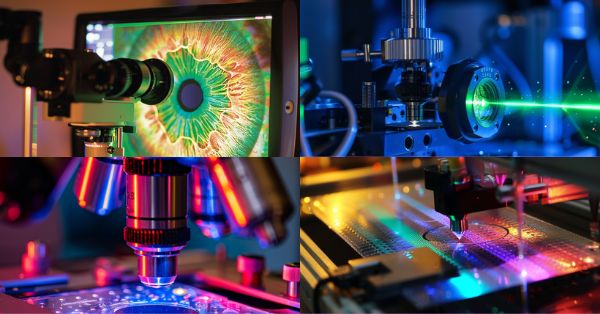Mar. 4, 2024

OCT and Fiber Coupler
The double-clad fiber coupler (DCFC) is an optical fiber-based coupler that preserves the single mode signal traveling through a double-clad fiber (DCF)'s core while enabling the effective injection and extraction of multimode light to and from the inner cladding of the DCF. Originating from Polytechnique Montreal, the DCFC initially emerged as an extraction-only coupler. Its primary role was to augment optical coherence tomography (OCT) measurements by detecting an additional imaging modality through the multimode inner cladding. Its evolution continued as an injection-only coupler, finding its application in precise light-based therapeutic procedures. The latest iteration, the bidirectional DCFC developed by Castor Optics, results from extensive research in coupler geometry. This version stands out because it enables low-loss and high-power concurrent excitation and collection of single and multimode signals. This dual functionality not only enhances existing applications but also opens new frontiers in various fields, such as LiDAR, telemetry, and free-space communication.
Key Technologies: Optical fiber, OCT
Quantitative Phase Microscopy
Research optical microscopy is dominated by fluorescence imaging which offers molecular specificity and controlled depth of field. However, sample labeling sometimes introduced bias and implies complicated sample preparation steps. Therefore, there is a need for label-free imaging, which is strongly answered by so-called quantitative phase imaging (QPI). We present here the implementation of QPI with a wave front sensor, which interfaces with a microscope like a camera without any further modification from a bright field configuration. We present QPI applications in cell metabolism follow-up and in particular, how cell dry-mass monitoring is a powerful tool to study cytotoxicity or the response to drugs. We also demonstrate how histopathology is simplified with QPI and does not alter the molecular content of tissues. In addition, we present images with specificity to fibers and other anisotropic molecules, without the need for nonlinear optics.
Key Technologies: quantitative phase imaging, fluorescence imaging, digital holography, wavefront sensing, interferometry
Multiphoton Microscopy and Deep Learning
Pancreatic cancer is a disease that could greatly benefit from intraoperative margin definition techniques. Two-photon microscopy (TPM) leverages nonlinear excitation to capture label-free tissue fluorescence, as well as second harmonic generation from non-centrosymmetric molecules such as collagen. Multispectral TPM utilizes multiple excitation wavelengths to probe specific fluorophores that together provide high contrast to differentiating healthy and cancerous tissue; however, analyzing and interpreting this high-dimensional dataset to provide actionable information to a surgeon remains a challenge. Deep learning methods have become an exceedingly powerful tool for automatic image analysis and classification. Used in concert, multispectral TPM and deep learning could enable rapid, quantitative and accurate tissue imaging. Our research explores the combination of multispectral TPM and deep learning for margin definition of pancreatic tumors. We have tested our technology both ex vivo and in vivo, showing over 95% classification accuracy, laying the framework for a for point-of-care device development and future in-patient testing.
Key Technologies: Two-photon microscopy, deep learning, convolutional neural network
On-Chip Spectroscopy
As the integration of lasers and other components on-chip continues to support new levels of functionality and complexity, the intersection of PICs and lab-on-a-chip technology is enabling chip-scale spectroscopic and analytical solutions for numerous applications. These include those targeting bio- and nanomedicine, as well as evanescent field sensing. Despite accelerated progress in both technology areas - integrated photonics and lab-on-a-chip instrumentation - technical bottlenecks, like CMOS scalability, remain in engineering these compact photonic platforms. This feature spotlights the integrated solutions that support this evolving industry trend, offering insight into the applications that are driving new chip designs and the integration of new on-chip photonic components. Conversely, the article pinpoints how technological developments chart a course for new applications.
Key Technologies: PICs manufacturing, lab-on-a-chip, waveguides, silicon photonics
Download Media Kit